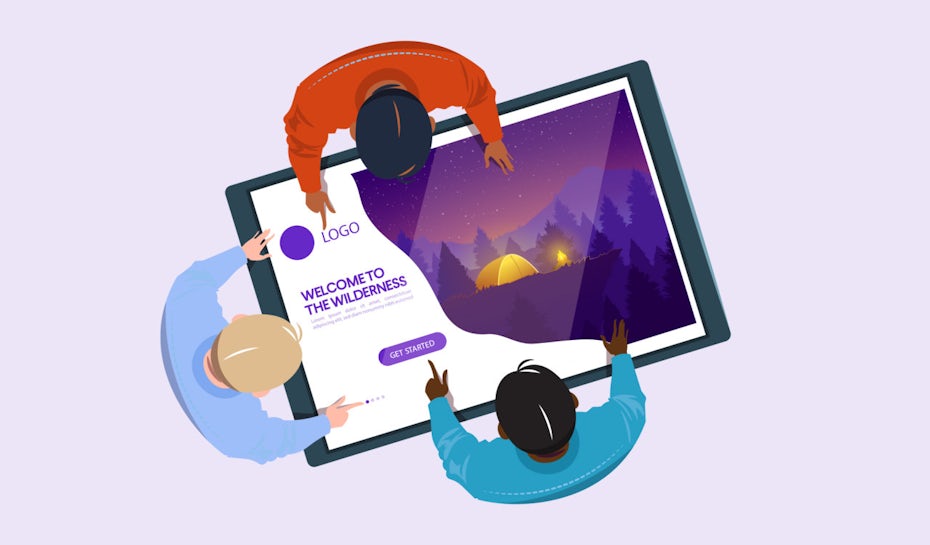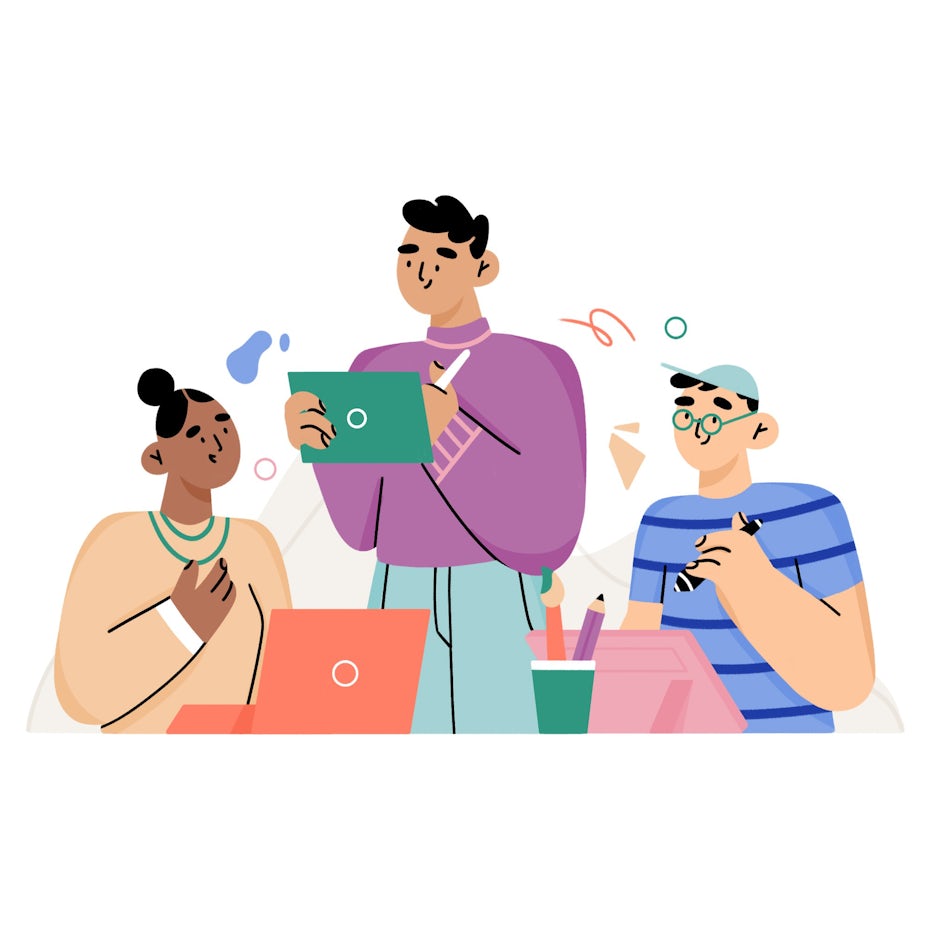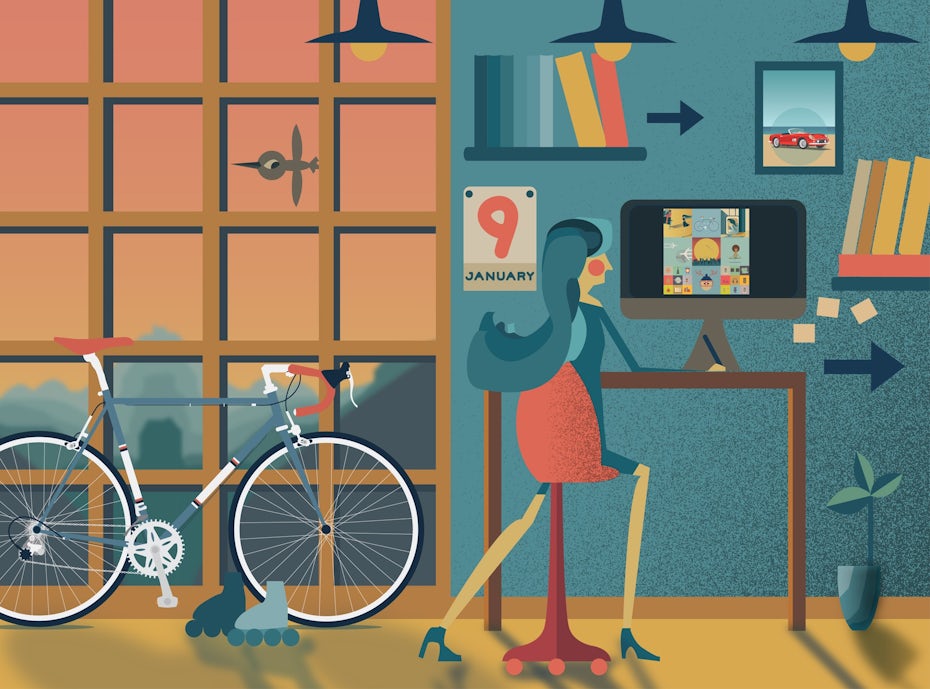What Does a Web Graphic Designer Do
Depending on whom you ask, web designers seem to do it all these days. That's because the term "web designer" is often used as an all-encompassing label for anyone who creates websites.

The truth is a bit more complicated than that. It takes a lot of planning, content creation, artistic effort, coding and hired specialists to make a website a reality. Web designers are one of those specialists, but they usually have a very specific role within the whole process. Whether you're looking to become a web designer or looking to hire one, it's important to familiarize yourself with what exactly web designers do and don't do. Otherwise, you might end up wasting time and money. With that in mind, let's walk through the typical responsibilities of a web designer and where they fit into the web development process.
What is web design?
—
Web design is the process of establishing the aesthetic appearance of a web page, including how content is arranged and how the elements of design are implemented. Web designers are typically focused on what is called the "front-end" of the website, the part of the website users actually see and interact with (as opposed to the "back end" code that makes the website function).

This means they can be responsible for choosing everything from the photos and imagery, the fonts, shape language, color scheme, buttons, as well as how all of these elements fit together. They use design software (such as Photoshop or Sketch) to create mockups, or image-based representations of how the final website should look once code is applied.
With that said, web designers are typically not responsible for building a working website—they focus on establishing the visual design only. Developers write the code that makes websites work, and website development requires a different skill set and sensibilities from design.
Where does a web designer fit into the process?
—
In order to understand what a web designer does, let's briefly go over the most common roles involved in the steps to create a website.
- Website strategist: Conducts in-depth market research to establish the business goals for the overall website and individual pages.
- Graphic designer: Creates visual brand elements—logo, color scheme, typography—and graphic assets—illustrations and icons—that are used on the website.
- Copywriter: Creates all written content—from headlines to body copy to button text—across the website.
- UX (user experience) designer: Focuses on the user's needs, and designs skeletal web page layouts (called wireframes) that optimize website elements around user behaviors and expectations.
- UI (user interface) designer: Designs interactive elements such as buttons and forms.
- Web designer: Focuses on all of the visual elements of a website, and turns wireframe layouts into finished web page designs.
- Front end web developer: Uses formatting languages and code (HTML, CSS, Javascript) to implement the web design onto a web browser.
- Back end web developer: Uses coding language to develop more complex functionality behind the scenes of a web page.

In short, a web designer refers to the goals set by a website strategist and a UX designer's wireframe, and combines the content from graphic designers, copywriters and UI designers into a finished web page mockup. Developers then take that design mockup file, separate and export the graphic elements, and use code to turn this into a live web page. This all means that if you are looking to hiring a web designer, you should have your strategy and most of your website content either roughed out or finished.
With all that said, do take these job descriptions with a grain of salt. They are generalizations and describe the traditional definitions of these roles. As mentioned earlier, many people use the term "web designer" broadly, so it can mean different things to different people. There can be overlap between roles—most web designers do their own market research, have graphic design and UX, and some can even double as developers (especially on the front end). It is also not uncommon for companies (or clients) to combine roles and responsibilities depending on their budget. Always make sure before you start a project that you are on the same page about your expectations for the role.
What are a web designer's responsibilities?
—
Let's get into a step by step breakdown of everything a web designer generally has to be responsible for in order to create finished web pages.
What a web designer does
- Visual design and layout: Often using wireframes and site maps, web designers order and arrange website content to optimize both visual communication, hierarchy and aesthetic sensibilities.
- Mobile and responsive design: Web designers also design the look of mobile and tablet versions of web pages.
- Static mockup files: Web designers create image files that represent the final look of the web page.
- Exportable design assets: Web designers layer their mockup files so that each page element can be easily separated and exported for developers to implement piece-by-piece onto a working web page.
- Photo editing: Web designers typically must be able to edit media assets that appear on the page.
- Formatting: Web designers often use some formatting languages (especially HTML and CSS) to implement and test their designs in web browsers.

What a web designer doesn't do
- Coding: Web designers focus on the visuals and are usually not responsible for coding the website.
- Writing: Web designers should not be expected to write any website copy. Many uselorem ipsumplaceholder text in their designs if the copy is not already prepared.
- Branding: Web designers are not responsible for creating logos or making broad visual brand choices as establishing the color scheme and fonts to be used on corporate assets outside of the web page.
- Illustration: Web designers typically do not create illustrations for the website. They incorporate graphic assets made by other professionals into their design. Some designers may design custom elements where needed.
- Photography: Web design and photography are separate disciplines. If the client has not hired a photographer, it is very common for web designers to select and incorporate stock photos into their design, the license of which the client must purchase.
- Animation: Custom animations should go through an interaction designer or professional animator.
- Market research: While web designers do perform some competitor research ahead of their design, they do not have access to all of the data, analytics, and expertise that an in-house marketing professional would. Usually, web designers depend on clients to deliver this information to them.
What skills do web designers need to have?
—

If you are thinking of becoming a web designer yourself, you should consider the kind of skills you will need in order to set yourself up for success. Although a college degree is certainly not a bad idea, it is increasingly common these days for designers to be self-taught, and there are plenty of web design tutorials available online.
Graphic design knowledge
At the end of the day, web designers aredesigners, and even if they aren't making logos, they should know how to combine text, copy, images, and color in a way that is visually pleasing. In particular, they should know how to strategically leverage the principles of design to create a desired effect on a viewer. This also includes knowledge of design history, knowing which design trends are still useful and which are overdone and tired.
Industry practices
Web design has been an established career path for over two decades now, and a number of design conventions and standard practices have been established with time. Because websites are software that users are meant to find intuitive, it is important to play into these conventions to meet user expectations, even while putting your own artistic spin on them. These conventions usually have to do with an approach to a design, and they range from standard website layouts, grid systems, mobile-first design and more. This is gained partially through experience, but also by paying attention to industry conferences and talks, like those posted to awwwards YouTube channel.
Software skills
Although the basics of a web page layout can start with a paper and pencil, eventually web designers need to use software to create files their team and/or clients can use. Photoshop is one of the most common software used for web design, but UX prototyping apps like Sketch have become increasingly popular amongst web designers. For more on this, refer to our list of the best web design software.
Web development knowledge
Although coding should typically be left to a developer, creating a website is a technical undertaking no matter which way you slice it. Web designers should be aware of technical capabilities and limitations, which is why it is often helpful to have some familiarity with code to know what design choices will work and what won't. Some design effects or textures may be difficult to implement with code, and some may result in file sizes that slow the loading of a web page.
Where can you find a web designer?
—
If you need to hire a web designer or you are curious about the options web designers have to find work, there are a number of possibilities. Many work in agencies and can be found through referrals from past employers or other colleagues. A common place to find web designers looking for work are professional networking and job sites such as LinkedIn.

But instead of wading through the profiles of all the users on a general purpose job listing site, a creative platform like 99designs can give you access to a global pool of professional freelance web designers. You can work with designers two ways: search for designers and contact one to negotiate rates and work one-to-one in a secure project space or you can run a contest in which you submit a project brief and multiple designers compete by submitting sample web page designs.
Find a web designer today
—
Web designers have a role to play in the building of a website, but contrary to popular opinion, they don't do everything. They are largely responsible for the visual construction of a web page. But considering that the visuals are the part of the website that users interact with, it is a big job worthy of a dedicated position. In order to get a standout web design, make sure you're working with a web designer who knows their role and how to do it well.
Want to get the perfect web design?
Work with our talented designers to make it happen.
What Does a Web Graphic Designer Do
Source: https://99designs.com/blog/web-digital/what-does-a-web-designer-do/
0 Response to "What Does a Web Graphic Designer Do"
Post a Comment